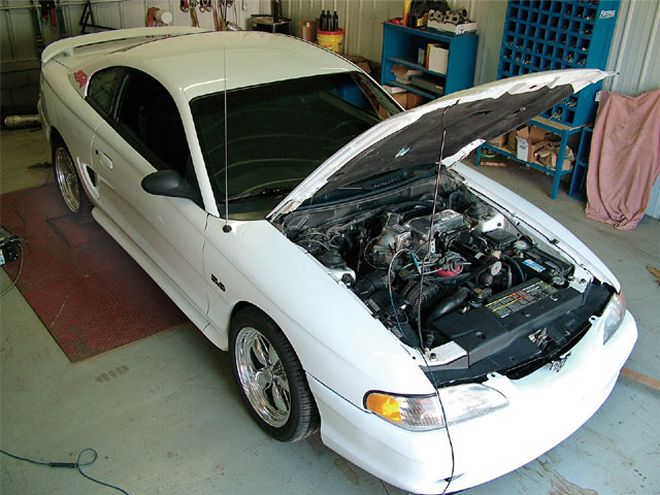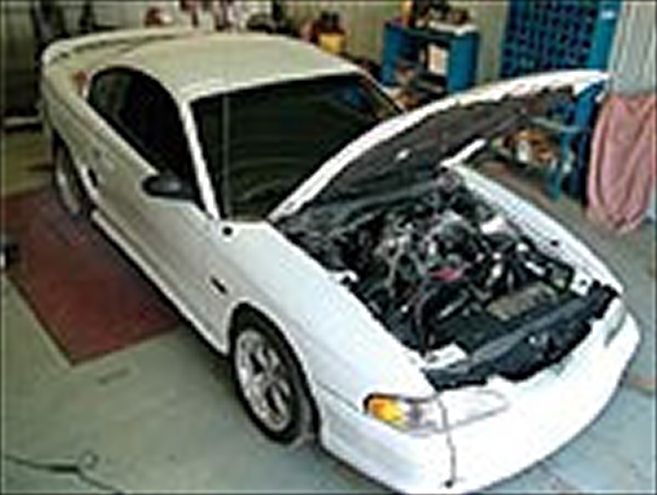


You have just completed the installation of your latest engine modification on your mass-air-equipped EFI Ford. It may have been something major like new heads, a blower, or a cam swap. It may have been something smaller like a new mass air meter, throttle-body, larger injectors, or air intake tube. Now it's time to test out your latest modification. In an ideal situation, you head off to your nearest chassis dyno, strap down the car, and make more power than ever before. But what if you don't? What if the car runs pig-rich and falls on its face?
Prior to EFI, the local carb guru could square your carb away in no time. Today's EFI cars are limited by the factory electronics, which were developed for the stock combination of parts. The high-end cars we often read about have stand-alone fuel management systems and full control of their fuel and spark curves, but perhaps you're not ready for anything like that yet. You could have a chip burned for your combination, but what if this is just the beginning of your project and you have several other modifications planned for the future?
Enter the Pro-M Remote Optimizer. This wonderful little black box goes in-line with the mass airflow meter and allows you to alter the signal back to the ECM, giving you a window of adjustment for your air/fuel ratio. The mass air meter in the Ford EFI system measures the amount of air entering the engine using a "hot wire" type sensor. The output of this sensor is directly proportional to the air flowing past it. Once the Remote Optimizer is installed, the simple twist of a screwdriver is all it takes to enrich or lean your fuel curve. It needs to be noted that this is a powerful tool that needs to be adjusted based on real data-not just seat-of-the-pants feel. There is a very real potential here for you to lean your engine and cause expensive internal damage.
The Remote Optimizer also gives you the ability to tune your mass air meter for different injector sizes (either smaller or larger than your meter's original calibration) without having to send your meter back in for recalibration. This allows you to install a new meter without downtime.
Our test car is a '94 Mustang GT with a Kenne-Bell 6-psi supercharger and aftermarket exhaust on an otherwise stock engine. It is an AOD car that is driven daily in the summer, rain or shine. When we purchased the car, it came with current dyno sheets proving that the power was down and the mixture was quite rich. We chose the Remote Optimizer over other options based on low cost and simplicity.
Installation was as simple as disconnecting the negative battery cable, unplugging the mass air meter, plugging it into the box, and plugging the lead from the box back into the meter. The only complication we had was that the connector on the '94-'95 Mustang is inside the airbox, so it had to be opened up and relocated outside the box. The resulting hole was patched with a small piece of sheetmetal held in place with screws. The '87-'93 cars do not have this problem.
Once the wiring was complete, we began the tuning process. We chose not to mount the box right away to retain easy access to the adjustment screws. Per the instructions, the box should first be adjusted for the correct injector size. The "HIGH SPD" screw would be set at "2" if you were installing injectors that were double what your meter was calibrated for. Since we are still running stock injectors and knew that our car was rich, we chose a setting slightly less than "1." The Optimizer is then adjusted for best idle quality by adjusting the "IDLE" screw. A digital voltmeter is used on the connections provided on the box to get the voltage set between 0.7 and 0.9 volts. Our car liked a little more than that, with the final setting bouncing around between 0.94 and 0.96 volts.
This car responded favorably on the first dyno pull with an increase of the air/fuel ratio of 2 points at high rpm, and a corresponding increase of 19.9 hp (a 10-percent improvement) and 12.3 lb-ft of torque. We saw the air/fuel ratio go past 13:1 over 5,000 rpm, so we richened the "HIGH SPD" screw a bit. Power went down slightly. The last step of our install was to tuck the box back behind the airbox and secure it and its wires with plastic ties. You may prefer to screw your box to the shock tower or inner fender depending on the location you choose and other parts on your car.
We were impressed with the results of the Remote Optimizer. Our car was a prime candidate for it, and it responded favorably across the whole rpm range. In addition, idle quality and driveability have improved and remained consistent with 3,000 miles of driving to date.